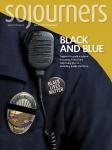DAN ZAK WAS FIRST struck by the absurdity of it all. As a reporter for The Washington Post, he was fascinated to learn that Sister Megan Rice, Michael Walli, and Greg Boertje-Obed had crossed forested hills in the middle of the night in Oak Ridge, Tenn., and reached the center of a government complex where possibly the most dangerous material in the world is enriched and stored.
Then Zak was captured by what was behind their action—the dramatic secrecy in the development of the first atomic bomb, the tragedy of its testing on U.S. soldiers and on the unsuspecting inhabitants of the Marshall Islands, the bungling bureaucracy surrounding the entire nuclear industry, and finally the hope and resilience of the resisters who work to eliminate these perilous weapons. His book Almighty: Courage, Resistance, and Existential Peril in the Nuclear Age (Blue Rider Press) is the result.
Rice, Walli, and Boertje-Obed called their action the Transform Now Plowshares, following a tradition of serious faith-inspired nonviolent actions dating back to 1980, actions often successful in reaching their nuclear targets and resulting in prison terms.
In July 2012, the trio cut through several fences—aided by malfunctioning motion sensors—at times moving through bright floodlight and past signs warning, “Deadly force authorized.” They hung a banner on one fence that proclaimed the words that were the source of their action, the injunction from Isaiah to “hammer their swords into plowshares and their spears into pruning hooks” (2:4).
They arrived at Y-12, a building that stores 800,000 pounds of weapons-grade uranium, the material that undergoes fusion when a nuclear bomb is detonated. Using traditional Plowshares action symbols, they streaked the white walls with the blood of activists, spurted from baby bottles they carried in their backpacks. They painted the building with the phrases “Woe to the empire of blood” and “The fruit of justice is peace.” They chipped away at the concrete walls with small hammers, and they waited.
Finally, a guard drove up and saw the three, hands outstretched and empty. Kirk Garland knew peace protesters, as he had worked for the Rocky Flats weapons plant in Colorado, so he didn’t fire but called for backup. He listened as they read their statement: “A loving and compassionate Creator invites us to take the urgent and decisive steps to transform the U.S. empire, and this facility, into life-giving alternatives. ... Blood reminds us of the horrific spilling of blood by nuclear weapons.”
Finally, other guards arrived and took them to jail. The final act of their resistance had begun—the long ordeal of trial, conviction, appeal, and finally release.
Behind the usual euphemisms
This became the most famous Plowshares action against nuclear weapons, mostly because it had revealed the woefully inadequate security in this and other “nuclear security” sites.
At trial for the break-in, before Michael Walli took the oath to “tell the whole truth and nothing but the truth,” he questioned whether, in a U.S. courtroom, he would even be allowed to use words that tell the truth. And in a sense, that’s what Dan Zak’s book is all about—the use of words to tell or to obscure the truth about the ways nuclear bombs can destroy the earth.
Almighty reads like a novel, with flashbacks and shameful details and sudden changes in style and subject worthy of the best contemporary fiction. But it’s anything but fiction. It’s an exploration of the truth about nuclear weapons and the multifarious words used to hide that truth.
Almighty forces the reader to focus on where truth is spoken. Is it in the prophetic voices from the Plowshares movement? Or is it in the words the government uses to talk about and fund what is truly unthinkable and mostly out of sight—the existential peril of the still-present nuclear age?
Early in the development of the nuclear bomb, Congress passed its management to for-profit business contractors and “created a thicket of [agencies] to shield and shepherd” it. Consequently, Congress never uses its (many) words to debate strategy and doctrine, but only bickers over budget. True to form, the hearing after the Oak Ridge break-in was long on words of shock and outrage but lacking in substantive policy discussion.
Almighty is a fascinating read. With clear scientific explanations and a detailed history, a masterful introduction of key players in both the nuclear arms race and a newly vibrant resistance, and an exciting retelling of the audacious actions of the resisters who reached the center of the Oak Ridge uranium plant, Zak’s work shows us weapons that not only make us less safe but claim victims even when not deployed, weapons that keep us in a peril so unthinkable that most people can’t talk about them in any meaningful way.
The government crafts words that hide this horror. What is this “national security site” nicknamed Y-12, these words and letters that don’t stand for anything? It’s a factory that makes thermonuclear cores for the most destructive weapons ever devised. At the Transform Now Plowshares trial, defense attorneys forced the for-profit managers who run Y-12 to use true words to describe their work instead of their usual euphemisms.
After the Transform Now Plowshares action, aging fences and nonfunctioning alarm systems at the Oak Ridge plant were repaired; management was reshuffled. Kirk Garland, the prudent guard who didn’t use deadly force, was fired. New training programs for guards were devised, but many aging buildings have not been replaced, thus subjecting the plant employees and their families in the surrounding area to ever-increasing danger.
At trial, Boertje-Obed pointed out that the Plowshares action had actually improved the lax security at the plant by exposing it. In response, Steven Erhart, manager for the plant from the National Nuclear Security Administration called the security upgrades a “normalization of the deviation from the optimum.” Huh?
Both prosecutor and judge spoke often of the activists’ disregard of the law. In his closing statement, Boertje-Obed reminded the court that in order to get the New START treaty signed by Congress, President Obama had to disregard the Nuclear Non-Proliferation Treaty and agree to fund and build three nuclear weapons factories—one of them in Oak Ridge. “These new factories will continue building weapons for 70, 80 more years, and that is a clear violation of the law,” concluded Boertje-Obed.
Nevertheless, the resisters were found guilty of vandalism and sabotage. The next day Judge Amul Thapar sent them to jail until sentencing because they had committed a “federal crime of terrorism.” In contrast, Ellen Barfield, a spokesperson for the nonviolent trio, said: “The real crime? Nuclear weapons.” Did she speak the true words, or did Judge Thapar? (An appeals court overturned the sabotage sentence in May 2015, and the three were released.)
Idols and destruction
“Almighty” is another word for God. Dan Zak’s book shows us how the United States has made gods of metal out of nuclear weapons, worshipping these multitudinous gods by pouring untold trillions into building, maintaining, and now modernizing bombs that are supposed to keep us safe but are actually making enemies, contaminating the earth forever, sapping our moral strength, and strangling our country by robbing it of necessary resources.
Reading Zak’s book gives me a new respect for the truth-telling of nuclear activists, including the watchdog group called Oak Ridge Environmental Peace Alliance, the Global Zero campaign, and ICAN, the International Campaign to Abolish Nuclear Weapons. At the latest Review Conference of the Parties of the Treaty on the Non-Proliferation of Nuclear Weapons at the U.N., the U.S. and U.K. blocked consensus, but the non-nuclear states got 107 countries to sign a resolution calling for the complete abolition of nuclear weapons.
For years, I’ve studied and participated in anti-nuclear protests. As an oral historian, I’ve collected and published interviews with Catholic Workers and other resisters, with long segments on the Plowshares movement in my latest books. So I knew the resisters and the spiritual and political rationale that grounds their resistance. But I was woefully ignorant of the fearsome technology behind the war-making they resist. Almighty shocked me, as it may you.
By comparing the facts on the ground—the physical, psychological, and political horrors the bomb has wreaked since its conception—to the words U.S. authorities use to describe it—the cover-ups, the denials of compensation for injury, the bureaucracy that has grown like a cancer over the nuclear industry and even on those in the government supposedly dedicated to containing it—Zak’s gripping book should bring nuclear weapons to the front of our national conscience.

Got something to say about what you're reading? We value your feedback!

